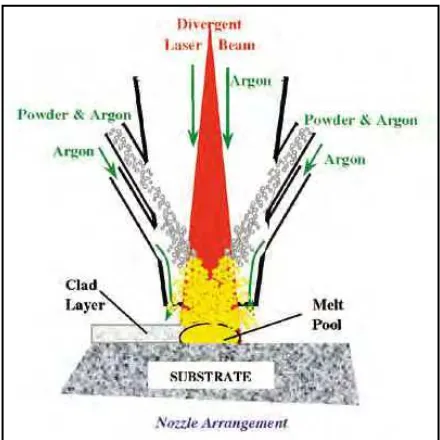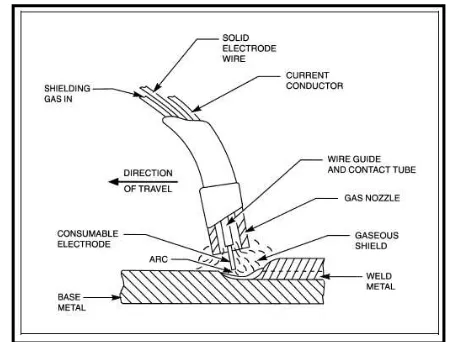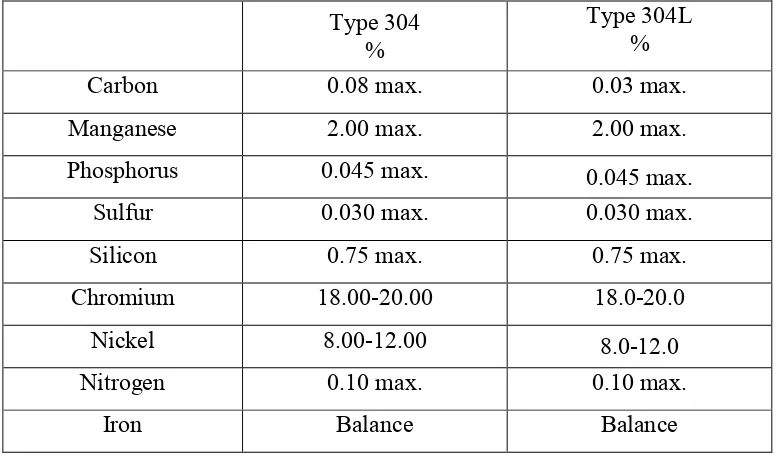UNIVERSITI TEKNIKAL MALAYSIA MELAKA
THE EFFECTS OF METAL INERT GAS (MIG) PROCESS
CONDITION ON HARDNESS OF STAINLESS STEEL CLADDINGS
OF A CARBON STEEL SUBSTRATE
This report submitted in accordance with requirement of the Universiti Teknikal Malaysia Melaka (UTeM) for the Bachelor Degree of Manufacturing Engineering
(Manufacturing Process)
by
AZRI SAFWAN BIN ABDUL HALIM B050710249
UNIVERSITI TEKNIKAL MALAYSIA MELAKA
BORANG PENGESAHAN STATUS LAPORAN PROJEK SARJANA MUDA
TAJUK: The Effects of Metal Inert Gas (MIG) Process Condition on Hardness of Stainless Steel Claddings of Carbon Steel Substrate
SESI PENGAJIAN: 2010/11 Semester 2
Saya AZRI SAFWAN BIN ABDUL HALIM
mengaku membenarkan Laporan PSM ini disimpan di Perpustakaan Universiti Teknikal Malaysia Melaka (UTeM) dengan syarat-syarat kegunaan seperti berikut:
1. Laporan PSM adalah hak milik Universiti Teknikal Malaysia Melaka dan penulis. 2. Perpustakaan Universiti Teknikal Malaysia Melaka dibenarkan membuat salinan
untuk tujuan pengajian sahaja dengan izin penulis.
3. Perpustakaan dibenarkan membuat salinan laporan PSM ini sebagai bahan pertukaran antara institusi pengajian tinggi.
4. **Sila tandakan (√)
SULIT
TERHAD
TIDAK TERHAD
(Mengandungi maklumat yang berdarjah keselamatan atau kepentingan Malaysia yang termaktub di dalam AKTA RAHSIA RASMI 1972)
(Mengandungi maklumat TERHAD yang telah ditentukan oleh organisasi/badan di mana penyelidikan dijalankan)
Alamat Tetap:
APPROVAL
This report is submitted to the Faculty of Manufacturing Engineering of UTeM as a partial fulfillment of the requirements for the degree of Bachelor of Manufacturing Engineering (Manufacturing Process). The members of the supervisory committee are as follow:
……… Main Supervisor
DECLARATION
I hereby, declared this report entitled “The Effects of Metal Inert Gas (MIG) Process Condition on Hardness of Stainless Steel Claddings of a Carbon Steel Substrate” is the
results of my own research except as cited in references.
Signature : ………....
Author’s Name : Azri Safwan Bin Abdul Halim
i
ABSTRACT
An experimental research titled “The effect of MIG process conditions on hardness of stainless steel claddings of a carbon steel substrate” has been carried out. The overall aim is to investigate how different deposition parameters affected macrostructure, microstructure and hardness variation of stainless steel deposited material. The cladding process will be conducted using metal inert gas (MIG) weld method. Background knowledge about metal deposition including form of materials, heat sources and its commercial application in relation to its cladding, process parameter, microstructure properties, hardness variation, and macrostructure also reviewed. This experimental method involves manipulating one variable (cladding parameter) to determine if changes in this variable cause changes in another variable (hardness variation). This method relies on controlled methods and the manipulation of variables to test a hypothesis. Finally, the hardness variation of cladding stainless steel was inspected using Rockwell test. In addition, Design Expert Software that implemented response surface methodology technique has been used in order to make sure the optimization of parameters while conducting this experimental research. This research had successfully analyzed the data collected from this experimental research. The effect of welding parameters such as current, voltage and travel speed are directly affected hardness variations of carbon steel cladding material. Finally, the suggestion to enhance the optimization of parameter in cladding
ii
ABSTRAK
iii
DEDICATION
For my beloved family:
Abdul Halim Bin Mohd Salleh Siti Sabariah Binti Muhammad Syariff
For my adored friends:
Muhammad Rabani Bin Othaman Amzar Bin Mat Yunus Azhar Bin Abdol Aziz Muhammad Aiman Bin Yusof
Muhd Ammar Bin Hassan Syukri Zarizi Bin Kamaruzan Muhammad Ikhwan Bin Muhammad
Kamarul Syaufi Bin Rasidi
iv
ACKNOWLEDGEMENT
Alhamdulillah and thank to Allah S.W.T. with all His Gracious and His Merciful for giving me strength and ability to accomplish this project research successfully. I would like to take the utmost opportunity to express my sincere and gratitude to my supervisor, Dr. Nur Izan Syahriah Binti Hussein who is always giving me supports and guidance throughout the semester in completing this ‘Projek Sarjana Muda’. Besides, thanks a lot to all lecturers and staffs of Faculty of Manufacturing Engineering.
Also with the greatest thanks to my beloved parents and family who always pray and give the encouragement while pursuing my research and project. Their sacrifices are never being forgotten.
v
2. LITERATURE REVIEW 6
2.1 Introduction 6
2.5.1 Effect of process parameter on dilution 14
2.6 Dilution 15
2.7 Microstructure 16
2.7.1 Solidification Mode 16
vi
2.9 Summary 19
3. EXPERIMENTAL METHODS 20
3.1 Introduction 20
3.5.2 Deposition Parameter 27
3.5.3 Cladding Process 28
3.6 Microscopical Technique 29
3.7 Rockwell Hardness Testing 30
3.8 Statistical Analysis (Response Surface Methodology) 32
3.8.1 Variable Machining Parameter 32
3.8.2 Response Variable 32
3.8.3 Design of Experiment Matrix 33
4. EFFECT OF PARAMETERS ON HARDNESS 34
4.1 Introduction 34
4.2 Design of Experiment 34
4.2.1 Design Factor 35
4.2.2 Design Summary 36
4.2.3 Relationship between Independent and Response Variable 37
4.2.4 Variables Criteria 40
4.2.5 Optimization of Variables 42
4.3 Summary 44
5. MACROSTRUCTURE, MICROSTRUCTURAL DEVELOPMENT
AND HARDNESS VARIATIONS OF CLADDINGS 45
5.1 Introduction 45
vii
5.2.1 Base metal Microstructure 46
5.3 Macrostructure of One Stainless Steel Clad 47
5.4 Microstructure Development of Stainless Steel Clad 48
5.4.1 Fusion Zone 50
5.4.2 Heat Affected Zone 51
5.5 Hardness Variation 52
5.6 Hardness Variation at Cladding Layer 53
6. DISCUSSIONS 54
6.1 Introduction 54
6.2 Effect of Current on Hardness 54
6.3 Effect of Voltage on Hardness 55
6.4 Effect of Travel Speed on Hardness 56
6.5 Optimization of Parameter Model versus Experimental 56
6.6 Establish Cladding Process 56
7. CONCLUSION AND FUTURE WORKS 57
7.1 Introduction 57
7.2 Summary of Research 57
7.3 Research Findings 58
7.4 Future Work Recommendation 58
viii
LIST OF TABLES
2.1 Chemical composition of the 304L stainless steel in wt% 8 2.2 Mechanical Properties of the 304L stainless steel in wt% 9
2.3 Properties of Clad Layer 11
2.4 Process parameter varied at five levels 13
2.5 Solidification types and microstructure 17
3.1 Nominal composition of stainless steel wire (ER308L) 25 3.2 The cladding conditions for plate thickness 5mm 27
3.3 Parameter and its limit 32
3.4 Design of Experiment Matrix 33
4.1 Design factor 35
ix
LIST OF FIGURES
1.1 High Power Diode Laser (HPDL) System 2
2.1 Metal Inert Gas Process 6
2.2 Laser Cladding Process 10
2.3 Two stage (preplaced) and one stage (in-situ) laser cladding 11 2.4 Effect of input numeric factors in GMAW process 14 2.5 Cross section of a single clad layer with definition of the clad geometry 16
2.6 Rockwell hardness 18
3.1 The flow chart of experimental research 21
3.2 Isometric View (Jig) 22
3.3 Orthographic View (Jig) 22
3.4 Isometric View (Bar) 23
3.5 Orthographic View (Bar) 23
3.6 Filler wire used in this experimental Process 24 3.7 Gas Metal Arc Welding (GMAW) Setup for Deposition Process 26
3.8 One layer clad 28
3.9 Seven layers clad by overlapping ¼ of the clad width 28
3.10 Optical Microscope 29
3.11 Grinder machine 29
3.12 Polisher machine 30
3.13 Rockwell hardness test diagram 31
3.14 Comparison between common hardness scales 31
4.1 Design Summary 36
4.2 Relationship between current and hardness 37
4.3 Relationship between voltage and hardness 38
4.4 Relationship between travel speed and hardness 39
x
4.6 Variable criteria for voltage 40
4.7 Variable criteria for travel speed 41
4.8 Variable criteria for hardness 41
4.9 Constraints and Solution for DOE 42
4.10 Relationship between optimal parameters and hardness 43
5.1 Macrostructure of low-carbon steel 0.1%-0.3% 44
5.2 Ferrite and Pearlite grain in Mild Steel Microstructure
at 20x magnification 44
5.3 130A (current), 24 inch per minute (travel speed) and 22V (arc voltage) 45
5.4 A) Current at 153A B) current at 130A 45
5.5 A) Travel speed at 32ipm B) travel speed at 27ipm 46 5.6 Cladding area and HAZ microstructure for optimal set of parameters 47 5.7 The fusion zone type FA that occurs at cladding
stainless steel (50X magnification) 48
5.8 Relationship of solidification type to the pseudobinary phase diagram 49 5.9 Ferrite along the austenitic grain boundaries in the HAZ 49 5.10 Hardness variation at different spot of cladding stainless steel 50
6.1 A) Current at 190A B) current at 115A 55
6.2 A) Result of calculation of the SDAS 55
xiv
LIST OF ABBREVIATIONS
CAD - Computer-Aided Design CRES - Corrosion-Resistant Steel DMD - Direct Metal Deposition
GMA - Gas Metal Arc
GMAW - Gas Metal Arc Welding GTA - Gas Tungsten Arc
GTAW - Gas Tungsten Arc Welding HAZ - Heat Affected Zone
LENS - Laser Engineered Net Shaping MIG - Metal Inert Gas
RSM - Response Surface Methodology SEM - Scanning Surface Microscopy TIG - Tungsten Inert Gas
AISI - American Iron Standard Institute AWS - American Welding Society
1
CHAPTER 1
INTRODUCTION
1.1 Introduction
Cladding is a well established process used in a variety of industries for improving the surface and near surface properties (wear, corrosion or heat resistance) of a part, or to resurface a component that has become worn through use. Cladding typically involves the creation of a new surface layer having different composition than the base material, as opposed to hardening which simply entails changing the properties of the substrate itself in a thin surface layer. There are currently quite a number of different techniques for performing cladding each with its own specific characteristics in terms of the materials employed, the quality of the clad layer and various practical issues including throughput speed, process compatibility, and cost. Laser based processes are amongst these techniques however, their implementation has been limited to both cost and various implementation factors.
2
Figure 1.1: High Power Diode Laser System (Neill Boyle, Aidan Kennedy & John Connolly (1999)).
1.2 Background of Problem
To improve the surface properties of metallic mechanical parts, such as the resistance against wear and corrosion, several thermal surface treatments are available for instance are flame spraying, plasma spraying and arc welding are established techniques. Characteristic for these techniques is the application of a surface layer with the required properties on top of a cheap material without those properties. Depending on the applied technique, common problems are a combination of a poor bonding of the applied surface layer to the base material, the occurrence of porosity, the thermal distortion of the work piece, the mixing of the surface layer with the base material and the inability of a very local treatment.
3 1.3 Problem Statement
Based on this study, several main points need to be focused and questions need to be answered at the end of the topic:
i. How different deposition parameters affected macrostructure and microstructure of stainless steel deposited material?
ii. How different deposition parameters affected hardness of stainless steel deposited material?
1.4 Objectives
Objectives of this study are as follows:
i. To investigate how different deposition parameters affected macrostructure and microstructure of stainless steel deposited material.
ii. To investigate how different deposition parameters affected hardness of stainless steel deposited material.
iii. To establish whether stainless steel can be deposited as cladding using MIG as heat source.
1.5 Overview of the Dissertations
Chapter 1 provide fundamental of cladding process and its applications. In addition, background of this research also reviewed in this chapter. Problem statement and objectives of this experimental research are stated based on the task given.
4
relation to its process parameter, dilution, and macrostructure and hardness variation. Summary of literature review is provided at the end of this chapter.
Chapter 3 describes an experimental method of this research including design of experiment, experimental flow, equipment set up and technique used. Introduction on some method and approach in selecting an optimize parameters for this experimental research also stated in this report. This chapter provides statistical analysis of direct metal deposition. The conclusion of this chapter would interpret as research flow along this research.
Chapter 4 describes the result of the design of experiment. Interpretation on some result and finding of this research also stated in this chapter. This chapter provides statistical analysis of the design of experiment. The main parameters of the process are current, voltage and travel speed. These parameters are not independent.
Chapter 5 describes a macrostructure, microstructure development and hardness variations of as-deposited stainless steel using wire feed method. Introduction on some method and approach in determining macrostructure, microstructure development and hardness variations of as-deposited also stated in this report. This chapter provides interpretation of experiment result and its discussion.
5 1.6 Activity Planning
6
CHAPTER 2
LITERATURE REVIEW
2.1 Introduction
This chapter presents a review of the literature about the effect of (MIG) process condition on dilution of stainless steel claddings of a carbon steel substrate. Beside, the literature about metal inert gas (MIG) heat source and process also review in this chapter. Background knowledge about stainless steel material is also provided in relation to its process parameter, macrostructure properties, microstructure properties and hardness variation. Summary of literature review is provided at the end of this chapter.
2.2 Metal Inert Gas (MIG)
MIG welding or GMAW is a process that melts and joints metals by joint metal by heating them with an arc established between a continuously fed filler wire electrode and the metals as shown in figure 2.1.
7
Shielding of the arc and the molten weld pool is often obtained by using inert gases such as argon or helium. This process applied a continuous and consumable wire electrode. Carbon dioxide or argon-oxygen mixtures are suitable for arc shielding when welding the low-carbon and low-alloy steels, while pure inert gas may be essential when welding highly alloyed steels (Kou, 2003).
Pure inert gas shielding is essential for welding alloys of aluminum, magnesium, copper, titanium, zirconium, stainless steels and nickel base super alloys. MIG welding is normally perform with direct current electrode positive because it provides a stable arc, smooth metal transfer, relatively low spatter loss and good weld characteristics. The gas metal arc process or metal inert gas process can be used for spot welding to replace either riveting, electrical resistance or GTA (TIG) spot welding (Lincoln Arc Welding 2001).
Originally developed for welding aluminum and other non-ferrous materials in the 1940s, MIG was soon applied to steels because it allowed for lower welding time compared to other welding processes. The cost of inert gas limited its use in steels until several years later, when the use of semi-inert gases such as carbon dioxide became common (Lincoln Arc Welding Foundation, 2001).
Advantages of using MIG welding according to Lincoln Arc Welding Foundation, (2001) are as follows:
a) Very clean due to the application of inert shielding gas
b) Higher deposition rate, thicker work pieces can be welded at higher speed c) Can master the welding skill in short time
2.3 Stainless Steel
In metallurgy, stainless steel, also known as inox steel or inox, is defined as a steel alloy with a minimum of 11% chromium content by mass. Stainless steel does not stain, corrode, or rust as easily as ordinary steel (it stains less, but it is not
8
grade are not detailed, particularly in the aviation industry. There are different grades and surface finishes of stainless steel to suit the environment to which the material will be subjected in its lifetime. Common uses of stainless steel are cutlery and watch cases and bands.
Stainless steel differs from carbon steel by the amount of chromium present. Carbon steel rusts when exposed to air and moisture. This iron oxide film (the rust) is active and accelerates corrosion by forming more iron oxide. Stainless steels have sufficient amounts of chromium present so that a passive film of chromium oxide forms which prevents further surface corrosion and blocks corrosion from spreading into the metal's internal structure.
2.3.1 Stainless steel composition
Stainless steel AISI 304 and 304L has a composition as shown below (Table 2.1) (Balbaud, 2007).
Table 2.1: Chemical composition of the 304L stainless steel in wt% (Balbaud, 2007).
Type 304
Phosphorus 0.045 max. 0.045 max.
Sulfur 0.030 max. 0.030 max.
Silicon 0.75 max. 0.75 max.
Chromium 18.00-20.00 18.0-20.0
Nickel 8.00-12.00 8.0-12.0
Nitrogen 0.10 max. 0.10 max.
9
Table 2.2: Mechanical Properties of the 304L stainless steel in wt% (Balbaud, 2007).
UTS
Stainless steel AISI 304L has a wide variety of applications in a condition where the following properties are important:
a) Resistance to corrosion
These steels exhibit excellent resistance to a wide range of atmospheric, chemical, textile, and petroleum and food industry exposures.
b) Resistance to oxidation
The maximum temperature can be exposed continuously without appreciable scaling is about 1650°F (899°C). For intermittent exposure, the maximum exposure temperature is about 1500°F (816°C).
c) Ease of fabrication d) Excellent formability e) Ease of cleaning
f) High strength with low weight
g) Good strength and toughness at cryogenic temperatures h) Readily available of a wide product forms



